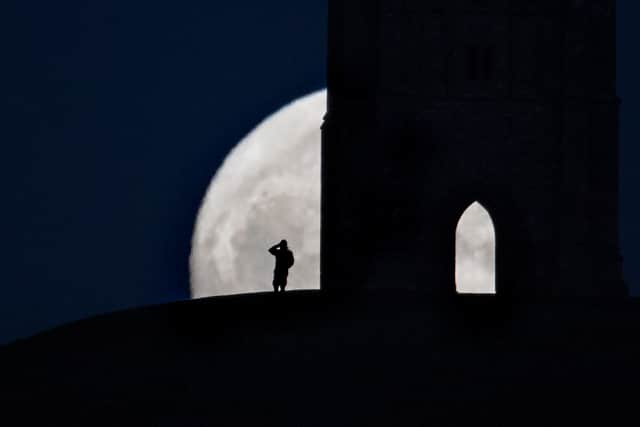January full moon 2024: is there a full moon tonight in UK, when is the next full moon - what is a Wolf Moon?
and live on Freeview channel 276
The first full moon of the year is set to take place this week. January's full moon - known as the Wolf Moon - will rise in the sky, bathing the night sky in its bright glow and providing a spectacular view for skygazers.
But just why is it known as the Wolf Moon, what's the best way to see it, and will it be a supermoon? Here is everything you need to know about it.
Advertisement
Hide AdAdvertisement
Hide AdWhen is the January 2024 full moon?
The January full moon will take place on Thursday 25 January.
The Moon will technically be at its fullest at 5:54pm, but will appear bright and magnificent throughout Thursday evening - weather permitting of course.
Why is it known as the Wolf Moon?
Like many other celestial events, the full moon of January holds significance in various traditions and folklore, providing a fascinating glimpse into the ways different societies have interpreted and named the lunar cycles.
The term "Wolf Moon" can be traced back to Native American and other indigenous cultures.
Advertisement
Hide AdAdvertisement
Hide AdThese communities often bestowed unique names upon full moons to mark the passing of time and seasons, creating a lunar calendar that served as a guide for their activities, particularly in agriculture and hunting.
The Wolf Moon, specifically, is associated with the deep winter months when wolves were believed to be particularly vocal, howling more frequently in the cold and still nights of January as they sought food during their breeding season.
The heightened activity and echoing calls of wolves in the winter landscape made a lasting impression on various cultures, leading to the association of the January full moon with the creatures.


What's the best way to see it?
As with all other full moons, the Wolf Moon will be easily viewable with the naked eye - assuming there isn't a thick layer of cloud obscuring your view.
Advertisement
Hide AdAdvertisement
Hide AdYou'll want to look for the full moon in the east at dusk, as it will rise directly opposite the setting sun. At that time, the Moon will also appear closer to the horizon, giving way to an optical illusion that can make it appear larger than at other points in the sky.
Of course, it's not really any bigger, but the illusion - helpfully known as the Moon Illusion - makes it seem that way because when the moon is near the horizon, it is viewed in relation to foreground objects like trees, buildings, or hills.
The presence of these objects provides visual cues for our brains to compare the size of the moon to familiar reference points on the Earth's surface. As a result, our brains interpret the moon as being larger than when it is higher up in the sky with no nearby reference points.
Will it be a super moon?
In January, the full moon rises high in the sky, and on a clear, cold night - with the aid of ice crystals hanging in the air - can appear brighter than usual. But is 2024's January full moon a supermoon?
Advertisement
Hide AdAdvertisement
Hide AdA supermoon is when the full moon looks bigger and brighter in the sky than usual. This happens because the moon's orbit around Earth is not a perfect circle, but more like an oval or ellipse.
When the moon is closer to Earth in its orbit (at its closest point called perigee) and it's also a full moon, that's when we see a supermoon. Because the moon is closer, it appears larger in the night sky, and since it's fully illuminated by the sun, it looks brighter.
2024's January full moon will not be a supermoon, but the phenomenon is not all that rare, with multiple regularly occurring in a single calendar year. In 2024, there are two - the full moons of September and October.
The other full moons of 2024:
- Snow Moon on Saturday 24 February
- Worm Moon on Monday 25 March
- Pink Moon on Wednesday 24 April
- Flower Moon on Thursday 23 May
- Strawberry Moon on Saturday 22 June
- Buck Moon on Sunday 21 July
- Sturgeon Moon on Monday 19 August
- Harvest Moon on Wednesday 18 September (SUPERMOON)
- Hunter’s Moon Thursday 17 October (SUPERMOON)
- Frost Moon on Friday 15 November
- Cold Moon on Sunday 15 December
Comment Guidelines
National World encourages reader discussion on our stories. User feedback, insights and back-and-forth exchanges add a rich layer of context to reporting. Please review our Community Guidelines before commenting.
